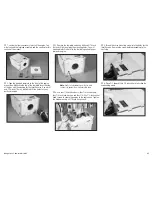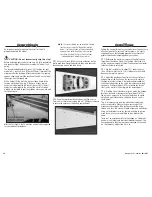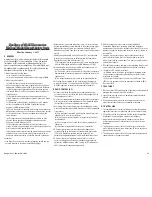
32
Hangar 9 33% Pawnee 80cc ARF
Safety Do’s and Don’ts for Pilots
• Consult local laws and ordinances before choosing a
location to fly your aircraft.
• Check all control surfaces prior to each takeoff.
• Do not fly your model near spectators, parking areas or
any other area that could result in injury to people or
damage of property.
• Do not fly during adverse weather conditions. Poor
visibility can cause disorientation and loss of control of
your aircraft. Strong winds can cause similar problems.
• Do not take chances. If at any time during flight
you observe any erratic or abnormal operation, land
immediately and do not resume flight until the cause of
the problem has been ascertained and corrected. Safety
can never be taken lightly.
• Do not fly near power lines.
Daily Flight Checks
• Check the battery voltage of the transmitter battery. Do
not fly below the manufacturer’s recommended voltage.
Doing so may cause your aircraft to crash.
When you check these batteries, ensure you have the
polarities correct on your expanded scale voltmeter.
• Check all hardware (linkages, screws, nuts, and bolts)
prior to each day’s flight. Be sure that binding does not
occur and that all parts are properly secured.
• Ensure all surfaces are moving in the proper manner.
• Perform a ground range check before each day’s flying
session.
• Prior to starting your aircraft, turn off your transmitter,
then turn it back on. Do this each time you start your
aircraft. If any critical switches are on without your
knowledge, the transmitter alarm will sound a warning.
• Check that all trim levers are in the proper location.
• All servo pigtails and switch harness plugs should be
secured in the receiver. Make sure the switch harness
moves freely in both directions.
Flying the hangar 9
33% Pawnee 80cc ARF
Congratulations on purchasing your H9 Pawnee! We are
confident you will have a wonderful flying experience with
this incredibly designed aircraft. The Pawnee has fantastic
slow-speed flight characteristics, and you will enjoy using
the flaps for all sorts of aerobatic flight maneuvers and
shooting tons of touch and go’s.
PRE FLIGhT
Make sure all strut attachments are secure. Make sure all
stabilizer bolts are tight and linkages are secure. Check fuel
and battery levels. Make sure cockpit doors are closed and
secured properly. Once you have done your pre flight checks,
you’re ready to fly.
TAKE OFF
The Pawnee will take off at very low speeds. For initial
flights, we recommend using full throttle for the initial climb
out before reducing speed. Taxi model into the wind and do
a final control check before advancing the throttle slowly.
The Pawnee has a lot of development that went into the
undercarriage and it is designed so that it will track fairly
straight with a small amount of right rudder. Continue to
advance the throttle to 100% power until flying speed is
achieved. As mentioned, the Pawnee will want to fly, so
be ready for it to lift off quicker than you would expect for
a model this size. Once you have reached a safe altitude,
reduce power settings substantially depending on which
engine choice you have used. If using a 60cc engine, half-
throttle will be plenty for a scale cruse. With an 80 to 100cc
engine, you can fly on 1/3–1/4 power once initial climb out
has been achieved. The Pawnee also has a full scale working
undercarriage, so even the roughest field will be ok. In
testing, many takeoffs were done on extremely rough grass
fields with no problems.
LANDING
Landings are the most fun with the Pawnee. For the first
few landings, we recommend landing without flaps. Slowly
reduce power and position the aircraft off the end of the
runway approximately 100’ high and 200’ out. Continue
to reduce the power back to idle. The Pawnee, without
flaps, will have a fairly flat approach concluded with a very
slow touch down. It likes to three-point as well as wheel
land. If you want a guaranteed no-bounce landing, wheel
landings are better. The next step is to try the flaps. We
would recommend only using the first stage to start, same
approach as without flaps, except that you want to be a little
closer off the end of the runway when reducing the power to
idle on final approach. Now here is where the fun starts—
you will notice that you can do a slightly steeper approach
and touchdown speed will be even slower (about 20%
slower than with no flaps). When deploying the flaps, you
will notice no trim change. This is one of the characteristics
of the Pawnee, so all that will happen is a slight slowing of
the model when you deploy the flaps. The next landing is the
full-flap approach. Again, same sort of approach as before,
however, you need to be even closer on the final approach
before reducing the power settings to idle. With full-flap, the
Pawnee can come in real steep without increasing speed.
GENERAL FLYING
The Pawnee is a real pussy cat. In fact, it’s almost like a
trainer to fly. It is very difficult to stall. Some fun things to do
is simulated crop dusting; flying real low to the ground with
the first stage of flaps deployed. The Pawnee is also quite
aerobatic. It will loop and roll and do quite a variety of other
maneuvers. Spins, 4-point rolls, even rolling circles have
been performed on the prototypes.
We hope you enjoy your Pawnee as much as we have when
developing this great aircraft for Hangar 9.





































